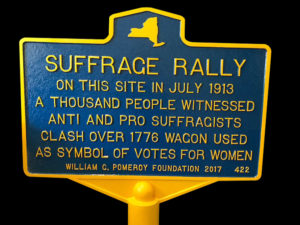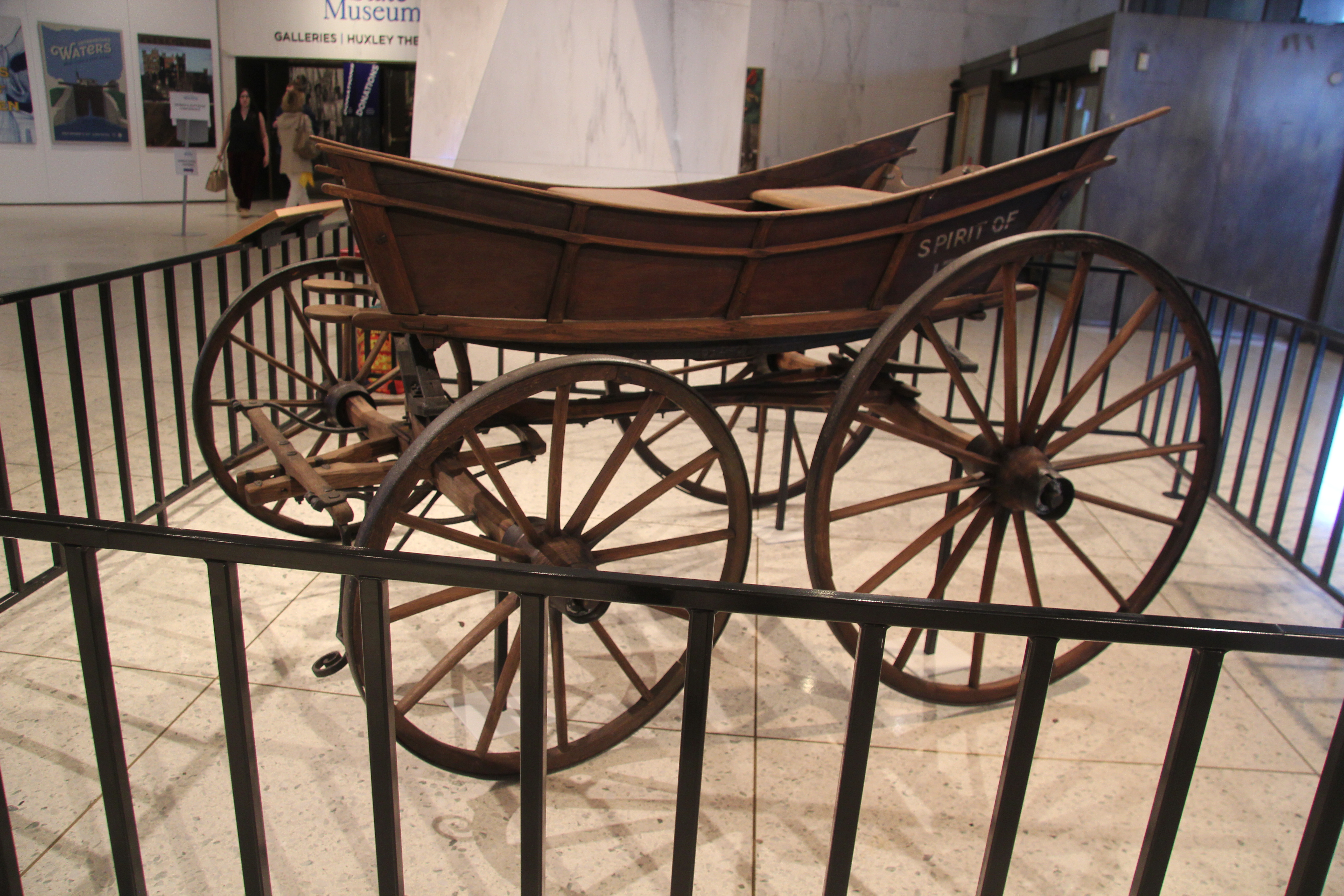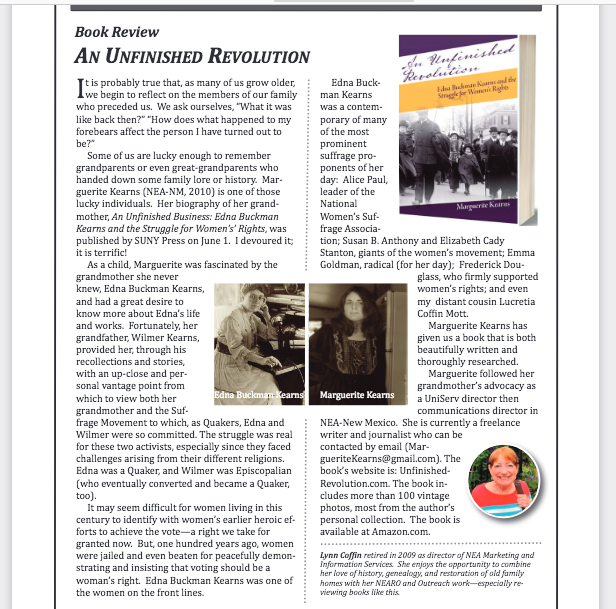The “Spirit of 1776″wagon caused an uproar in July of 1913.

THE HOW AND WHY OF WHAT HAPPENED:
by Marguerite Kearns
Back in elementary school, no teacher of mine ever mentioned that during the war for independence significant numbers of Americans identified themselves with the British.
Nothing demonstrates this more clearly than Long Island as portrayed in a previous A&E television series, “TURN: Washington Spies” that started its first season on television in 2014.
The tensions within Rosalie Jones’ own family on Long Island made the issue of Tory loyalties simmer and spill into the public arena in 1913 in the town of Huntington, NY. If it hadn’t been for the “Spirit of 1776” suffrage wagon and its 1913 journey for Votes for Women organizing on Long Island, the polarization of the population so long after the war for independence might not have come to light.
THE PLAYERS IN THE 1913 CONTROVERSY: BETWEEN TORY AND PATRIOT DESCENDANTS
The players in July 1913: Suffrage activist Edna Kearns who drove the horse-drawn wagon called the “Spirit of 1776” into Huntington, NY and Mary Livingston Jones, the mother of suffragist Rosalie Jones. Mrs. Jones identified herself as the descendant of Long Island Tories and demanded that the activists immediately stop their use of the “Spirit of 1776” wagon. Edna Kearns told a Brooklyn Daily Eagle reporter (who covered the incident) that Mrs. Jones’ tirade made her fear for her life.
Mrs. Jones insisted the old horse-drawn wagon had been in the possession of Tory descendants the previous century, and she threatened legal action against the New York State Woman Suffrage Association for misrepresenting its history. The clash between those in favor of voting for women and those against represented the polarization in the larger culture as well.
The confrontation at the Huntington, NY parade had no doubt been provoked by the disagreements suffragist Rosalie Jones had with her mother and sister. Jones family members considered themselves the elite of Long Island for their long-time residency and old money. In a 1913 article from the Brooklyn Daily Eagle, Mrs. Jones spoke of Tories and their prominence on Long Island as if the war for independence just happened recently.
A GREAT TIME TO REVIVE THE SPIRIT OF 1776 STORY . . .
Long Island was divided in loyalties in 1776. A significant number of colonial sympathizers moved to New England after the Battle of Long Island. And the island became even more entrenched in loyalist support in the aftermath of the British capture of New York City. This was well portrayed in “TURN: Washington’s Spies” during its 2014 first season, enough for the intrigue and spy thriller to hook two million Americans and have them glued to their TV sets.
Mrs. Mary Livingston Jones halted the Votes for Women parade in July 1913 with her claim that the “Spirit of 1776” wagon had been in the possession of her ancestors, the Hewletts, before the suffrage movement decided on the vehicle’s use for grassroots organizing on Long Island. It was, therefore a Tory icon, not a patriot one, Mrs. Jones insisted.
The suffragists disagreed and proceeded to carry their own message of patriotic protest to towns and villages all over Long Island during the summer of 1913. More than 20 newspapers, including the New York Times, covered the splash caused by the “Spirit of 1776” wagon and its supporters at suffrage demonstrations, rallies, and special fundraising events. No legal action resulted, despite Mrs. Jones’ threats. Without the confrontation in Huntington, NY, we wouldn’t be privy to the fact that Long Island remained polarized between loyalists and patriots, on some level at least, more than a century after the end of the war for independence.
COLONEL HEWLETT PORTRAYED AS IN THE WRONG PLACE AT THE WRONG TIME
In the “TURN: Washington’s Spies” series, the Hewlett name was attached to the TV character wearing a red British uniform, not a bad guy actually –more like a decent guy in an extremely awkward situation.
A 1913 Long Island history clearly identifies the Hewletts as the largest and most powerful of all Tory families on Long Island. So it shouldn’t have been necessary for the TV series to import a Hewlett from England to wear a red coat. In actuality, Hewlett represented a well-known household name for Tory support on Long Island. Hewlett family members remained on Long Island after the American war for independence after they officially declared their loyalty to the new nation.
DID THE TORY CONVERSIONS MAKE PEOPLE FORGET THEIR PREVIOUS LOYALTIES?
In a story documented by a Brooklyn Daily Eagle reporter in 1913, Mrs. Jones made it clear that her relatives, the Hewletts, resented being linked to the colonial cause.
Long term, the Hewletts’ conversion to patriots seems to have been enough for family members to continue living on Long Island after the American Revolution without limping around, tails between their legs. Later, Hewlett family members became the source for stories told to the suffrage activists that the “Spirit of 1776” wagon had been a symbol of patriotism, not Tory loyalties. The suffragists took advantage of the opportunity to spread this patriotic protest message in 1913.
Patriotic protest had been a key theme of the suffrage movement going back to 1848 when the Seneca Falls, NY signers of the Declaration of Sentiments linked their civil rights struggle to the spirit of 1776 and the American Revolution. In 1913, Edna Kearns and other activists dressed in colonial costumes and highlighted the patriotic protest theme.
But the Hewletts couldn’t shed their loyalist associations easily. The state education department, back when the agency was in charge of historical street markers, produced one marker to stand in front of the home of Richard Hewlett in Rockaway, NY. There, Richard Hewlett was acknowledged as the local Tory who planned the capture of General George Washington.
Long Island newspaper accounts during the 1920s suggested that Tory loyalties and the threats on the life of George Washington were, in the opinion of many local residents, best forgotten.
IN OTHER NEWS: The State of New York announced in 2017 that it had initiated a program to build a statue of Rosalie Jones in a state park on Long Island. The planning for the statue is underway.



0 Comments